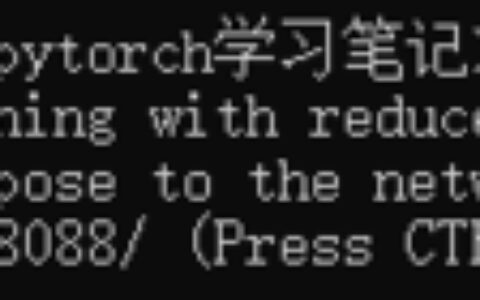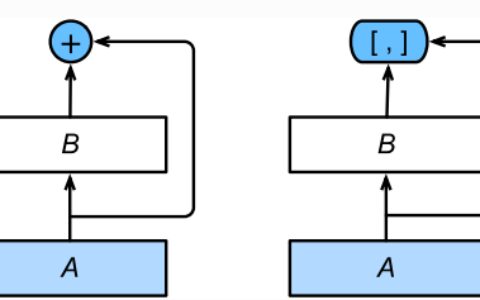今天在看网上的视频学习深度学习的时候,用到了CIFAR-10数据集。当我兴高采烈的运行代码时,却发现了一些错误:
# -*- coding: utf-8 -*-
import pickle as p
import numpy as np
import os
def load_CIFAR_batch(filename):
""" 载入cifar数据集的一个batch """
with open(filename, 'r') as f:
datadict = p.load(f)
X = datadict['data']
Y = datadict['labels']
X = X.reshape(10000, 3, 32, 32).transpose(0, 2, 3, 1).astype("float")
Y = np.array(Y)
return X, Y
def load_CIFAR10(ROOT):
""" 载入cifar全部数据 """
xs = []
ys = []
for b in range(1, 6):
f = os.path.join(ROOT, 'data_batch_%d' % (b,))
X, Y = load_CIFAR_batch(f)
xs.append(X)
ys.append(Y)
Xtr = np.concatenate(xs)
Ytr = np.concatenate(ys)
del X, Y
Xte, Yte = load_CIFAR_batch(os.path.join(ROOT, 'test_batch'))
return Xtr, Ytr, Xte, Yte
- 1
- 2
- 3
- 4
- 5
- 6
- 7
- 8
- 9
- 10
- 11
- 12
- 13
- 14
- 15
- 16
- 17
- 18
- 19
- 20
- 21
- 22
- 23
- 24
- 25
- 26
- 27
- 28
- 29
- 30
- 31
- 32
错误代码如下:
'gbk' codec can't decode byte 0x80 in position 0: illegal multibyte sequence- 1
于是乎开始各种搜索问题,问大佬,网上的答案都是类似:

然而并没有解决问题!还是错误的!(我大概搜索了一下午吧,都是上面的答案)
哇,就当我很绝望的时候,我终于发现了一个新奇的答案,抱着试一试的态度,尝试了一下:
def load_CIFAR_batch(filename):
""" 载入cifar数据集的一个batch """
with open(filename, 'rb') as f:
datadict = p.load(f, encoding='latin1')
X = datadict['data']
Y = datadict['labels']
X = X.reshape(10000, 3, 32, 32).transpose(0, 2, 3, 1).astype("float")
Y = np.array(Y)
return X, Y- 1
- 2
- 3
- 4
- 5
- 6
- 7
- 8
- 9
- 10
竟然成功了,这里没有报错了!欣喜之余,我就很好奇,encoding=’latin1’到底是啥玩意呢,以前没有见过啊?于是,我搜索了一下,了解到:
Latin1是ISO-8859-1的别名,有些环境下写作Latin-1。ISO-8859-1编码是单字节编码,向下兼容ASCII,其编码范围是0x00-0xFF,0x00-0x7F之间完全和ASCII一致,0x80-0x9F之间是控制字符,0xA0-0xFF之间是文字符号。
因为ISO-8859-1编码范围使用了单字节内的所有空间,在支持ISO-8859-1的系统中传输和存储其他任何编码的字节流都不会被抛弃。换言之,把其他任何编码的字节流当作ISO-8859-1编码看待都没有问题。这是个很重要的特性,MySQL数据库默认编码是Latin1就是利用了这个特性。ASCII编码是一个7位的容器,ISO-8859-1编码是一个8位的容器。
还没等我高兴起来,运行后,又发现了一个问题:
memory error- 1
什么鬼?内存错误!哇,原来是数据大小的问题。
X = X.reshape(10000, 3, 32, 32).transpose(0,2,3,1).astype("float")- 1
这告诉我们每批数据都是10000 * 3 * 32 * 32,相当于超过3000万个浮点数。 float数据类型实际上与float64相同,意味着每个数字大小占8个字节。这意味着每个批次占用至少240 MB。你加载6这些(5训练+ 1测试)在总产量接近1.4 GB的数据。
for b in range(1, 2):
f = os.path.join(ROOT, 'data_batch_%d' % (b,))
X, Y = load_CIFAR_batch(f)
xs.append(X)
ys.append(Y)- 1
- 2
- 3
- 4
- 5
所以如有可能,如上代码所示只能一次运行一批。
到此为止,错误基本搞定,下面贴出正确代码:
# -*- coding: utf-8 -*-
import pickle as p
import numpy as np
import os
def load_CIFAR_batch(filename):
""" 载入cifar数据集的一个batch """
with open(filename, 'rb') as f:
datadict = p.load(f, encoding='latin1')
X = datadict['data']
Y = datadict['labels']
X = X.reshape(10000, 3, 32, 32).transpose(0, 2, 3, 1).astype("float")
Y = np.array(Y)
return X, Y
def load_CIFAR10(ROOT):
""" 载入cifar全部数据 """
xs = []
ys = []
for b in range(1, 2):
f = os.path.join(ROOT, 'data_batch_%d' % (b,))
X, Y = load_CIFAR_batch(f)
xs.append(X) #将所有batch整合起来
ys.append(Y)
Xtr = np.concatenate(xs) #使变成行向量,最终Xtr的尺寸为(50000,32,32,3)
Ytr = np.concatenate(ys)
del X, Y
Xte, Yte = load_CIFAR_batch(os.path.join(ROOT, 'test_batch'))
return Xtr, Ytr, Xte, Yte
- 1
- 2
- 3
- 4
- 5
- 6
- 7
- 8
- 9
- 10
- 11
- 12
- 13
- 14
- 15
- 16
- 17
- 18
- 19
- 20
- 21
- 22
- 23
- 24
- 25
- 26
- 27
- 28
- 29
- 30
- 31
- 32
import numpy as np
from julyedu.data_utils import load_CIFAR10
import matplotlib.pyplot as plt
plt.rcParams['figure.figsize'] = (10.0, 8.0)
plt.rcParams['image.interpolation'] = 'nearest'
plt.rcParams['image.cmap'] = 'gray'
# 载入CIFAR-10数据集
cifar10_dir = 'julyedu/datasets/cifar-10-batches-py'
X_train, y_train, X_test, y_test = load_CIFAR10(cifar10_dir)
# 看看数据集中的一些样本:每个类别展示一些
print('Training data shape: ', X_train.shape)
print('Training labels shape: ', y_train.shape)
print('Test data shape: ', X_test.shape)
print('Test labels shape: ', y_test.shape)
顺便看一下CIFAR-10数据组成:

附件:CIFAR-10 python version下载地址
CIFAR-10官网
本站文章如无特殊说明,均为本站原创,如若转载,请注明出处:Python3读取深度学习CIFAR-10数据集出现的若干问题解决 - Python技术站


 微信扫一扫
微信扫一扫  支付宝扫一扫
支付宝扫一扫 

